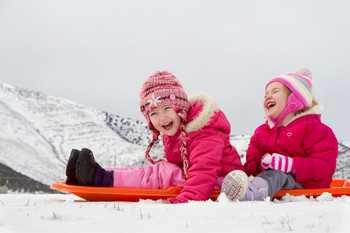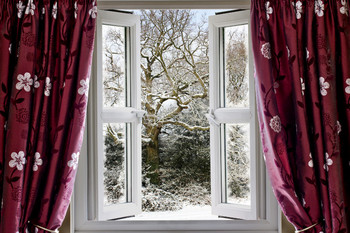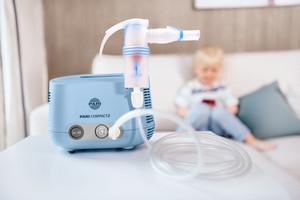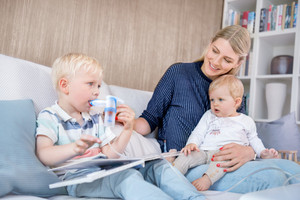
Children seem to be especially susceptible to colds in the winter, and are always coughing or sniffing. No sooner have they battled off one infection, than the next is waiting round the corner. This leaves their parents feeling stressed and worried. The paediatric pneumologist Prof. Dr. med. Carl-Peter Bauer, formerly the medical director of the Paediatric Clinic Schwabing at the Munich Technical University, explains in an interview what parents can do if their child has an infection – and what they can do to prevent the infection in the first place.
Prof. Dr. C.-P. Bauer: We must remember that viral infections in children are part and parcel of their normal immune system development. The climate in autumn and winter also makes viruses more prevalent. This means that children in a crèche or nursery school will infect each other - so they stumble from one respiratory infection to the next. Eight to twelve mild respiratory infections a year are part of the normal development of the immune system in this age group, without there having to be a more serious problem.
To prevent respiratory infections, it is important that the mucosal membranes in the airways are intact. And having working mucosal membranes means that they have to stay moist. Moist mucosal membranes are less susceptible to viruses than if they are dry and irritated.
Therefore, avoiding factors that irritate the airways helps prevent viral respiratory infections. This can be, for instance, passive smoking or fine dust that develops, for instance, when burning wood in a wood burner. Whenever you smell the seemingly homely scent of burning wood, you can assume that the wood burner is releasing fine dust.



Other important factors for a good room environment are the temperature and humidity. A temperature of around 18 degrees Celsius and humidity between 40 and 60 percent are ideal for a bedroom. It is important to regularly let in a breeze: several times a day for at least five minutes. It is also helpful to regularly go out in the fresh air, making sure the child is wrapped up warm.
Regularly washing hands - both at home and in the crèche or nursery school - can reduce the risk of spreading infection. Another important point: drink plenty (water or tea) and eat a balanced diet with plenty of fruit and vegetables. If your child has an unbalanced diet, you should speak to their paediatrician to see if your child needs to take vitamin supplements. This especially applies to vitamin D.
In children who stumble from one infection to another, regular inhalation therapy with 0.9% saline solution can be used to moisten the mucous membranes. Saline solution is available as a medical device from pharmacies. Your child should inhale two to three millilitres of 0.9% saline solution once to twice a day using an electric inhalation device such as the PARI COMPACT2 following consultation with the paediatrician. If the child catches a respiratory infection, you can increase this to three times a day.

Prof. Dr. C.-P. Bauer: Here we have to answer a few questions first: Does the child have an infection with or without a high fever? Does your child have a dry, tickly cough or a productive, phlegmy cough? Is your child’s breath whistling?
If the infection involves a dry cough and fever over 39 degrees Celsius, it can help to reduce the temperature with medicine or suppositories. Calf wraps can also help. The child should drink plenty to avoid an infection.
If their nose is blocked it can help to give them a short course of nose drops. Especially in the evening this can help them breathe easier. You can give the child cough medicine to help against a dry cough. Remember that the aim of the cough medicine is to supress the urge to cough. Moistening the airways by inhaling 0.9% saline solution can also help.

With a wet, phlegmy, productive cough the focus of treatment is to loosen the mucus. Here it is also important that the child drinks plenty and inhales with 3% saline solution. This helps shift mucus better than the 0.9% solution. Inhalation with a nebuliser also generally has a self-cleaning effect on the airways (mucociliary clearance).
If your child makes a whistling sound when they breathe, you should take them to the paediatrician. The same applies if the child’s general state of health is significantly compromised. The doctor can ascertain whether it is a serious disease such as the start of a lung infection.
Prof. Dr. C.-P. Bauer: Cough medicines have to pass through the gastrointestinal tract to be absorbed and then transported to where they are needed. With inhalation therapy, the saline solution acts directly on the airways – precisely where the mucus has to be loosened.
Prof. Dr. C.-P. Bauer: If your child is not already using inhalation therapy anyway to prevent infections, they should start as soon as possible at the first signs of an infection.
Prof. Dr. C.-P. Bauer: As mentioned above, they should inhale 0.9% saline solution to keep their airways moist. If there is a heavy build-up of mucus in the airways, 3% saline solution can loosen mucus more effectively. Depending on how the infection affects breathing, the inhalation therapy can be extended with a doctor’s prescription.

Prof. Dr. C.-P. Bauer: Basically, you should not use pots of hot water as there is the risk of scalding. Also, the droplets of salt solution with a water bath are too large to reach the lungs when we breathe in. This is only achieved with an inhalation device, like the PARI COMPACT2.
Prof. Dr. C.-P. Bauer: With children, it is especially important that they do not do their inhalation therapy for too long, so you should also ensure that you use an inhalation device with as short an inhalation time as possible. The device should also produce a sufficient number of small aerosol droplets so that as much inhalation solution reaches the lower airways as possible. Of course, a high quality, reliable device that works when it is needed is always helpful.
Prof. Dr. C.-P. Bauer: Introduce the inhalation to your child as a game. Let your child switch the device on or let them hold the nebuliser to check it out. Could it be that your child does not want to do the inhalation therapy because they do not know exactly what will happen? Show them using their favourite soft toy or doll how the inhalation therapy works so that they are no longer afraid of it.
Note: The information in this blog post is not a treatment recommendation. The needs of patients vary greatly from person to person. The treatment approaches presented should be viewed only as examples. PARI recommends that patients always consult with their physician or physiotherapist first.
An article written by the PARI BLOG editorial team.
© 2025 PARI GmbH Spezialisten für effektive Inhalation